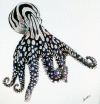Behavior and Body Patterns of the Larger Pacific Striped Octopus
- PMID: 26266543
- PMCID: PMC4534201
- DOI: 10.1371/journal.pone.0134152
Behavior and Body Patterns of the Larger Pacific Striped Octopus
Abstract
Over thirty years ago anecdotal accounts of the undescribed Larger Pacific Striped Octopus suggested behaviors previously unknown for octopuses. Beak-to-beak mating, dens shared by mating pairs, inking during mating and extended spawning were mentioned in publications, and enticed generations of cephalopod biologists. In 2012-2014 we were able to obtain several live specimens of this species, which remains without a formal description. All of the unique behaviors listed above were observed for animals in aquaria and are discussed here. We describe the behavior, body color patterns, and postures of 24 adults maintained in captivity. Chromatophore patterns of hatchlings are also shown.
Conflict of interest statement
Figures





Similar articles
-
Social tolerance in Octopus laqueus-A maximum entropy model.PLoS One. 2020 Jun 10;15(6):e0233834. doi: 10.1371/journal.pone.0233834. eCollection 2020. PLoS One. 2020. PMID: 32520975 Free PMC article.
-
Intramantle inking: a stress behavior in Octopus bimaculoides (Mollusca: Cephalopoda).J Am Assoc Lab Anim Sci. 2011 Nov;50(6):943-5. J Am Assoc Lab Anim Sci. 2011. PMID: 22330791 Free PMC article.
-
Den-Associated Behavior of Octopus rubescens Revealed by a Motion-Activated Camera Trap System.Integr Comp Biol. 2022 Oct 29;62(4):1131-1143. doi: 10.1093/icb/icac124. Integr Comp Biol. 2022. PMID: 35869966
-
How nervous systems evolve in relation to their embodiment: what we can learn from octopuses and other molluscs.Brain Behav Evol. 2013;82(1):19-30. doi: 10.1159/000353419. Epub 2013 Aug 21. Brain Behav Evol. 2013. PMID: 23979453 Review.
-
An embodied view of octopus neurobiology.Curr Biol. 2012 Oct 23;22(20):R887-92. doi: 10.1016/j.cub.2012.09.001. Curr Biol. 2012. PMID: 23098601 Review.
Cited by
-
Social tolerance in Octopus laqueus-A maximum entropy model.PLoS One. 2020 Jun 10;15(6):e0233834. doi: 10.1371/journal.pone.0233834. eCollection 2020. PLoS One. 2020. PMID: 32520975 Free PMC article.
-
Squid adjust their body color according to substrate.Sci Rep. 2022 Mar 28;12(1):5227. doi: 10.1038/s41598-022-09209-6. Sci Rep. 2022. PMID: 35347207 Free PMC article.
-
Investigating body patterning in aquarium-raised flamboyant cuttlefish (Metasepia pfefferi).PeerJ. 2016 May 17;4:e2035. doi: 10.7717/peerj.2035. eCollection 2016. PeerJ. 2016. PMID: 27231657 Free PMC article.
-
Tactical Tentacles: New Insights on the Processes of Sexual Selection Among the Cephalopoda.Front Physiol. 2019 Aug 21;10:1035. doi: 10.3389/fphys.2019.01035. eCollection 2019. Front Physiol. 2019. PMID: 31496951 Free PMC article. Review.
-
Individually unique, fixed stripe configurations of Octopus chierchiae allow for photoidentification in long-term studies.PLoS One. 2023 Apr 12;18(4):e0265292. doi: 10.1371/journal.pone.0265292. eCollection 2023. PLoS One. 2023. PMID: 37043461 Free PMC article.
References
-
- Moynihan MH, Rodaniche AF (1977) Communication, crypsis, and mimicry among cephalopods. How animals communicate: 293–302.
-
- Voss GL (1968) Biological Investigations of the Deep Sea. 39. Octopods from the R/V Pillsbury Southwestern Caribbean Cruise, 1966, with a description of a new species, Octopus zonatus . Bulletin of Marine Science 18: 645–659.
-
- Moynihan M (1985) Communication and noncommunication by cephalopods: Indiana University Press; Bloomington, IN.
-
- Moynihan M, Rodaniche AF (1982) The behavior and natural history of the Caribbean Reef Squid Sepioteuthis sepioidea with a consideration of social, signal, and defensive patterns for difficult and dangerous environments. Fortschritte der Verhaltensforschung/ /Advances in Ethology. Supplements to Journal of Comparative Ethology, 25, 151 pages.
-
- Rodaniche AF (1991) Notes on the behavior of the Larger Pacific Striped Octopus, an undescribed species of the genus Octopus . Bulletin of Marine Science 49: 667.
Publication types
MeSH terms
LinkOut - more resources
Full Text Sources
Other Literature Sources

